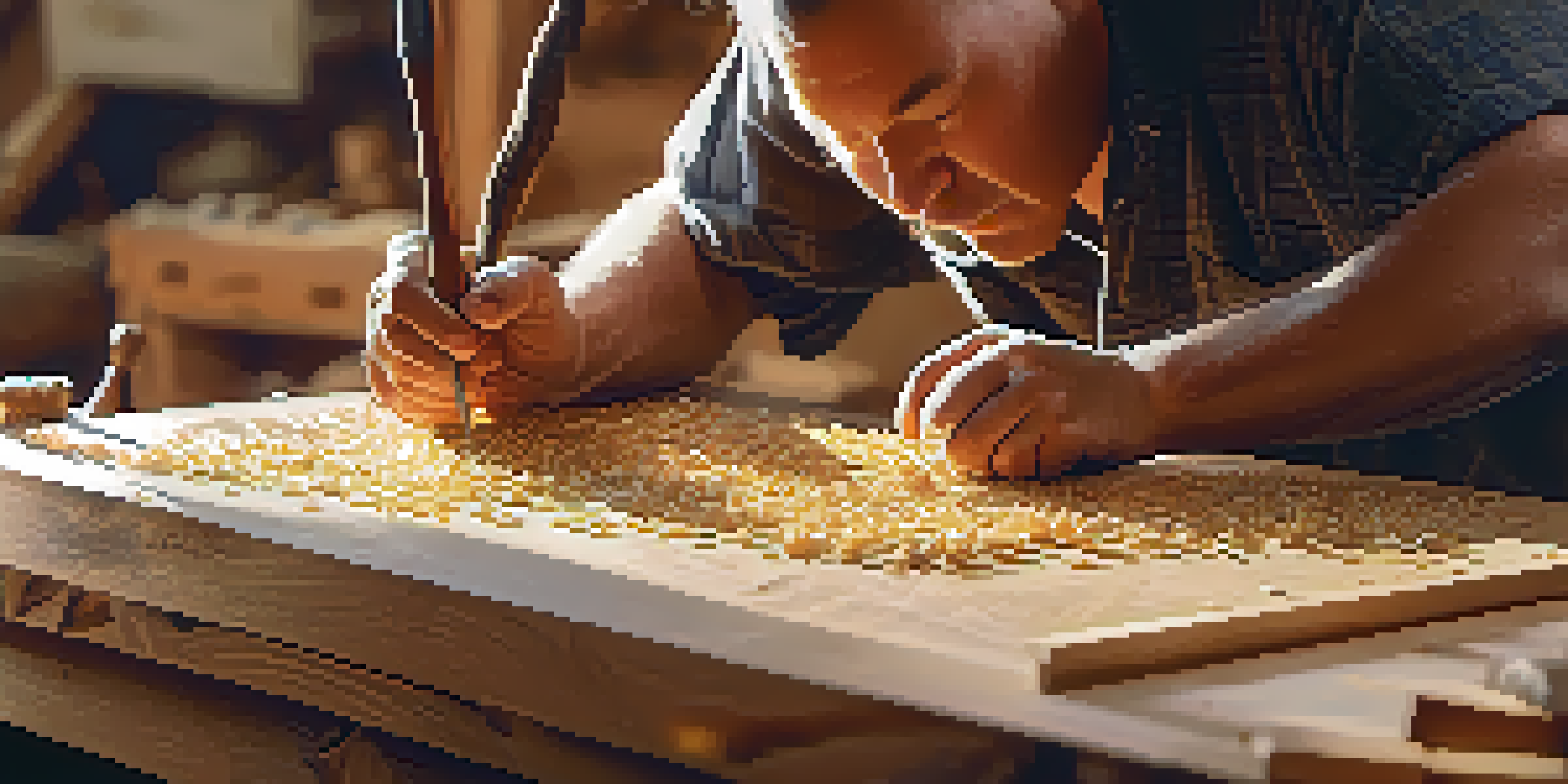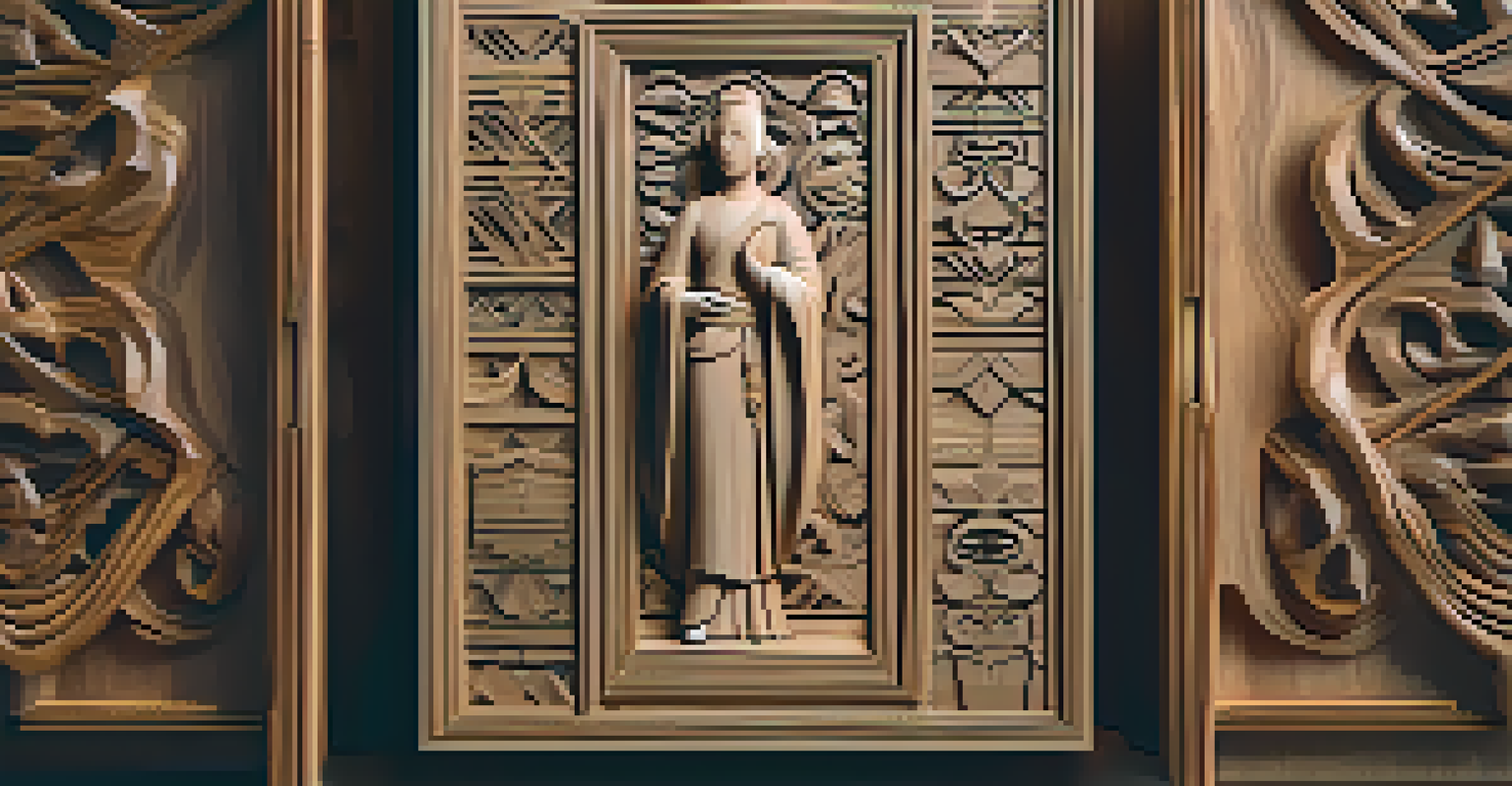Traditional vs. Digital Carving: A Comparative Analysis

Understanding Traditional Carving Techniques
Traditional carving is an age-old craft that involves using hand tools to shape materials like wood, stone, or ivory. Artists rely on their skills, intuition, and experience to create intricate designs, often passed down through generations. This method emphasizes the tactile experience of working with materials, connecting the artist closely with their craft.
Art is not freedom from discipline, but disciplined freedom.
The process of traditional carving can be time-consuming but allows for a deep connection to the medium. The artist's hand movements and decisions shape the final result, making each piece truly unique. This method often involves techniques like chiseling, whittling, and relief carving, which require patience and precision.
Moreover, traditional carving is often celebrated for its authenticity and originality. Each stroke of the tool tells a story of the artist’s journey, and the imperfections can add character and charm to the finished piece. This connection to history and tradition is something many artists and collectors cherish.
The Rise of Digital Carving Technologies
In contrast, digital carving utilizes advanced technology to create designs using computer software and machinery like CNC routers and laser cutters. This method can produce intricate patterns and shapes with incredible precision and speed. As technology evolves, digital carving has become more accessible to artists, offering new possibilities for creativity.

Digital tools allow artists to experiment and iterate designs more quickly than traditional methods. With just a few clicks, they can modify patterns, adjust sizes, or even visualize their creations in 3D before production. This flexibility can be particularly beneficial for larger projects or commercial applications.
Traditional vs. Digital Carving
Traditional carving emphasizes hands-on techniques and personal expression, while digital carving leverages technology for precision and efficiency.
However, some argue that digital carving lacks the warmth and personal touch of traditional techniques. While the precision of machines can achieve stunning results, the emotional connection and craftsmanship inherent in hand-carving may feel absent. This ongoing debate highlights the unique qualities of both approaches.
Comparing the Tools Used in Both Techniques
Traditional carving relies on hand tools such as chisels, knives, and gouges, each designed for specific tasks. These tools require skillful handling and can vary greatly in size and shape depending on the artist's preference and the project’s demands. The tactile nature of these tools often leads to a more immersive and personal experience.
Every artist dips his brush in his own soul, and paints his own nature into his pictures.
On the other hand, digital carving employs software programs and machinery that can automate much of the carving process. Tools like CAD (Computer-Aided Design) software and CNC machines allow for high levels of detail and efficiency. These tools can replicate designs accurately and produce multiple copies of a piece, which is a significant advantage for mass production.
While both sets of tools have their strengths, they also present different challenges. Traditional tools demand a deep understanding of material properties and hand-eye coordination, while digital tools require technical knowledge of software and machinery operation. Each method has its learning curve, shaping the artist’s journey.
Exploring Artistic Styles and Expressions
Artistic expression in traditional carving is often rooted in cultural heritage and personal storytelling. Many artists draw inspiration from nature, folklore, or historical events, creating pieces that resonate on a deeper emotional level. The imperfections in traditional carvings can enhance the narrative, making each piece a reflection of the artist’s soul.
In contrast, digital carving opens up a realm of possibilities for modern styles and experimentation. Artists can blend various influences and create complex, multi-layered designs that might be difficult to achieve by hand. The ability to manipulate and combine elements digitally allows for innovative approaches that push the boundaries of traditional art forms.
Education Shapes Artistic Skills
Mastering carving techniques relies on different educational approaches, with traditional methods focusing on mentorship and digital methods utilizing structured learning.
However, this does not mean that digital carving lacks depth or meaning. Many digital artists infuse their work with personal significance and draw from their experiences, much like traditional artists. The key difference lies in the medium and how it influences the final expression.
The Role of Education in Both Methods
Education plays a crucial role in mastering both traditional and digital carving techniques. Traditional carving often relies on mentorship and hands-on experience, where aspiring artists learn from seasoned professionals. Workshops, classes, and apprenticeships can provide invaluable insights into the nuances of hand tools and material properties.
Conversely, digital carving education often takes place in formal settings such as art schools or online courses. Students can learn software skills, design principles, and machine operation in a structured environment. Access to tutorials and online resources has made it easier for anyone to get started with digital carving, regardless of their background.
Ultimately, the choice of education method can shape an artist's style and approach. Some may prefer the tactile learning of traditional carving, while others may thrive in the dynamic environment of digital design. Both paths offer unique opportunities to explore creativity.
The Environmental Impact of Carving Techniques
Both traditional and digital carving methods have environmental implications, particularly concerning material usage and waste. Traditional carving requires natural materials like wood and stone, which, if sourced sustainably, can minimize ecological harm. However, overharvesting and deforestation can pose serious threats to the environment.
Digital carving, while often seen as more efficient, relies heavily on electricity and can generate waste from materials used in the process. Many digital artists are now seeking eco-friendly materials and methods, such as repurposing leftover materials or using biodegradable options. This shift reflects a growing awareness of environmental responsibility in the arts.
Sustainability in Carving Practices
Both traditional and digital carving have environmental impacts, but artists can adopt sustainable practices to minimize their ecological footprint.
Ultimately, both methods can be practiced sustainably, but it requires conscious effort from the artist. Choosing sustainable materials and practices can help mitigate the impact of carving on the environment and promote a more eco-friendly approach to art.
The Future of Carving: A Harmonious Blend?
As we look toward the future, it's clear that traditional and digital carving techniques are not mutually exclusive. Many artists are beginning to blend both approaches, utilizing digital tools for design while employing traditional methods for execution. This hybrid model allows artists to enjoy the best of both worlds and expand their creative horizons.
This fusion can lead to innovative works that combine the precision of digital carving with the warmth and individuality of hand-carved pieces. Artists can create unique, limited-edition works that resonate with audiences on multiple levels. This approach not only preserves traditional techniques but also embraces modern advancements.

In essence, the future of carving is about collaboration and innovation. By embracing both methods, artists can push the boundaries of their craft, creating pieces that honor the past while looking to the future. This harmonious blending can inspire a new generation of creators to explore the art of carving.